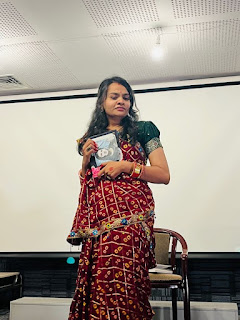Mahesh Dattani's Final Solutions
Hello. This blog is assigned by Prakruti ma'am for the paper 202- Indian English Literature Post-Independence, unit 3. This is a reflective blog in which I will share my experience of attending a drama workshop conducted by research scholar Alpa Ponda ma'am, who is pursuing her Ph.D. in "Drama Pedagogy" in the literature classroom, on the drama "Final Solution" by Mahesh Dattani, 1993. Afterward, I will address critical questions about the same drama.
Department of English organized the workshop, which started on July 15, 2024, and lasted until July 22, 2024. It was my first experience of being part of a drama workshop. I had heard about the workshop before, but being part of it was a new experience. Acting is not my forte, but I always wondered and tried to imagine how characters in novels would speak, dress, and feel.
On the first three days, we learned about tonation and intonation in speech. We prepared a small solo performance on the second day and received feedback from ma'am for improvement. During this process, we learned to use even the body as a prop. We also explored body movement, profile, and stage crafting. Wings and even the staging are integral parts of drama.
Apart from that, we learned to express the nine bhavas suggested by Bharat Muni in the Natya-shastra. Abhinaya, through the body, face, and expression, is the basic element. We practiced Angika, which familiarized us with the stage and helped us overcome body stiffness and move freely during performance.
Then we had Vachikam, meaning the reading of the play, which is totally different from reading a novel. Alpa ma'am provided a demo, and in groups, we read the whole play. We enhanced our speaking skills. In this process, we understood the characters' depth and the complexity of the environment. While doing Vachikam, I was able to understand Daksha's dilemma and Hardika's bias.
Vachikam was helpful in understanding the characters' maturity and how they speak according to their age, dress, atmosphere, and yes, the chorus was the heart of the drama. Even during Vachikam, ma'am assigned characters to everyone so they could understand the situation.
Mahesh Dattani, from the very first, provided stagecraft by highlighting how the characters would sit and stand. He even suggested a ramp where the chorus would stand. This place reflects the outside world. The chorus altogether reflects the mass that simultaneously turned into Hindu and Muslim. The central character Hardika with the use of dairy goes into the past, here Dattani manipulate the time.
Daksha had a bitter past experience with Zarin and her family. Hardika, in the present time, connects this bitter incident with the two Muslim boys. Daksha's loss of her father is constantly linked to this experience. Whenever she witnesses something that triggers her past wounds, she immediately jumps back to that time. The boys' arrival leads her back to the painful memories of Zarin's family.
Moreover, she asks them to leave the house, and her hatred erupts when she recalls the domestic violence inflicted on her by her in-laws. Dattani meticulously captures this temporal shift by positioning Daksha in the corner and Hardika in the front. Noor Jahan's songs connect Daksha and Hardika. Even Ramnik uses papers to connect with the past. Dattani uses the ramp as the outside world and the house as a microcosm of society, where liberal people like Smita, Ramnik, and Bobby clash with biased individuals like Javed, Hardika, and Aruna.
Guilt is an essential theme of the play. If we look at Ramnik, he epitomizes guilt. His actions, like sheltering Bobby and Javed, offering Javed a job, and providing food, are reactions to his guilt. He claims to be liberal and behaves in ways to prove it. However, his liberalism is rooted in guilt.
On the other hand, Hardika is entirely unaware of her in-laws' intentions towards Zarin's family. Her in-laws' guilt is reflected in their offer of help. Smita also feels guilty about following traditions like puja, fasting, and purification. She endures this for her mother's happiness. This guilt of unwilling compliance rebounds when she resists her mother.
Hardika's guilt peaks when Ramnik reveals the truth about burning the shop and buying the Muslim family's shop. Her final dialogue, "When will they come back?" and Ramnik's reply, "If we call, they will," reflect this guilt. The guilt of Javed which drives his actions of the attacking the Hindu rathyatra and Pujari. His gulit for some extend reveled reveled in his weaker moment. Ramik and Javed's conflict is central to revele the theme of the guilt.
They counter attack each other on thier weaker point which is hidden in every human especially Indians. Indias have deeply rooted prejudice in their mind for the communal hatred, for being psudo-secularist where one small attack on the religion turned out people shallow in thier behaviour.
Thank you.





















No comments:
Post a Comment